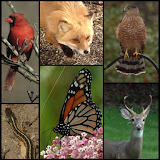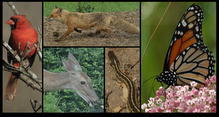Tuesday, April 06, 2010
Tuesday, March 23, 2010
Tongue of Red-Bellied Woodpecker
Previously, I posted a limited number of photos showing woodpeckers and hummingbird tongues. Today, I took video of the tongue of a male red-bellied woodpecker in action. When the snow was too deep to get needed suet to the feeders, I hung this feeder just outside of the porch windows. Over the last few weeks, the birds - primarily the woodpeckers - continued to come and eat the suet. The cone shape is a result of the suet sticking to the top of the cage feeder and the reach of the woodpeckers' longer beaks.
Where does this woodpecker store his tongue? The tongue slides to the back of the head, loops upward around the back of the inside of the skull, and then forward around and under the eye.
Posted by
Gil Miller
at
12:01 AM
0
comments
![]()
Labels: Red-Bellied Woodpecker, Tongue, Woodpecker
Monday, March 22, 2010
Blizzards of 2010: American Robins - Annual Migration
With snow on the ground, the robins were a reminder of a coming spring.
Posted by
Gil Miller
at
12:01 AM
0
comments
![]()
Labels: American Robin, Blizzards of 2010
Sunday, March 21, 2010
Blizzards of 2010: Carolina Wren Seeks Cover
Posted by
Gil Miller
at
12:01 AM
0
comments
![]()
Labels: Blizzards of 2010, Rhododendron, Wren
Saturday, March 20, 2010
Blizzards of 2010: Red-Tailed Hawk and Red-Shouldered Hawk
The next morning, this red-tailed hawk arrived and perched in the same spot.
This hawk would perch, then fly out, make a circle, and then perch again.
In the two above photos, you can see the red-tailed hawk's wing feathers as viewed from above and below. The dark upper feathers and the white lower feathers provide protection from predators - though which predators is never clear to me.
And here is the reason for the name - the clearly red tail,
Posted by
Gil Miller
at
12:01 AM
0
comments
![]()
Labels: Blizzards of 2010, Red-Shouldered Hawk, Red-tailed Hawk
Friday, March 19, 2010
Blizzards of 2010: Signs of the Fox
These first two photos were taken the second morning after the second February storm. How do I know that these are fox tracks? First, the night before, in the near-full moonlight, I observed a male fox come up the hill into the back yard, mark the snow, proceed to the front yard, and then run down the newly plowed driveways. Second, the tracks map nearly identically to the path of the foxes in December - even the curve over the to small bush under the snow - the bush the male had marked in December. Why the deep tracks? The snow had yet to crust over.
Third, the tracks came up the hill, to the general location that I observed in the moonlight the male fox marking by raising his leg. The next morning the fox urine was clearly visible on the snow covered bush that served as a house for the birds and squirrels.
24 hours later - the next morning - just before sunrise, this female red-tailed fox arrived and sniffed around under the feeder. How did I know it was a female?
Simple, the male raises his leg to make and the female - per the above photo - squats to let their marks.
You can see that even on this third morning after the storm, the fox is leaving deep tracks as the snow still had not crusted over. Sorry for the poor quality of the photos, but they were taken in near darkness.
Posted by
Gil Miller
at
12:01 AM
0
comments
![]()
Labels: Blizzards of 2010, Red-tailed Fox
Thursday, March 18, 2010
Blizzards of 2010: Red-Bellied Woodpecker and Yellow-Bellied Sapsucker
Here the male red-bellied woodpecker defends the suet feeder from the nearby starling while a female red-bellied woodpecker flies away.
Like the other woodpeckers, the red-bellied woodpecker enjoys the sap on the maples even if he has to dodge the icicles.
Here the red-bellied woodpecker perches on the oak branches.
And here is the reason the red-bellied woodpecker is called red-bellied. It is very hard to see this patch of red when he is attached to a tree trunk. The other woodpecker in the photo is a yellow-bellied sapsucker.
The yellow-bellied sapsucker shows up every year in the Colvin Run Habitat during the middle two weeks of February. Clearly a migratory time, as the yellow-bellied sapsucker usually winters south of Northern Virginia and summers north. In this photo, the yellow-bellied sapsucker enjoys the maple sap (of course) during the morning after. The second blizzard delivered over 8" of snow to the branch. For the record, the second storm delivered 30" of snow to the Habitat. The winter total was over 70" setting a season record at nearby Dulles Airport.
Posted by
Gil Miller
at
12:01 AM
0
comments
![]()
Labels: Blizzards of 2010, Red-Bellied Woodpecker, Woodpecker, Yellow-bellied Sapsucker
Wednesday, March 17, 2010
Blizzards of 2010: Downy Woodpeckers
During February, all of the woodpeckers - even the downies - spend time on the maple trees to feed on the sap that is running.
All of the woodpeckers keep an alert eye for trouble while on the maples.
In a few months, the leaves will prevent this small woodpecker from being seen at this position on the tree.
Posted by
Gil Miller
at
12:01 AM
0
comments
![]()
Labels: Blizzards of 2010, Downy Woodpecker, Woodpecker
Tuesday, March 16, 2010
Blizzards of 2010: Northern Cardinals
Even the female cardinals standout during the snow storm.
With the white or gray background, it seems easier to catch them in flight. This male extends his wings with the feathers fully exposed.
This female is photographed making an approach to the feeder.
And this make is actually flying up to a tree limb, but he is flying away from the camera. The result is a full exposure of his back and top of his wings.
Posted by
Gil Miller
at
12:01 AM
0
comments
![]()
Labels: Blizzards of 2010
Monday, March 15, 2010
Blizzards of 2010: Bird Count in the Storm
- Two starlings on a tree branch
- One red-shouldered hawk. This hawk perches often on that branch with his back to the birds at the feeder.
- Two cardinals at the sunflower seed feeder
- One downy woodpecker at the suet feeder under the cardinals
- One starling at the large suet feeder
- One starling perched at the pole top
- One cardinal at the suet feeder - yes you can hardly see this one
Posted by
Gil Miller
at
12:01 AM
0
comments
![]()
Labels: Blizzards of 2010, Colvin Run Habitat
Sunday, March 14, 2010
Blizzards of 2010: Peak of the Storms

Posted by
Gil Miller
at
12:01 AM
0
comments
![]()
Labels: Blizzards of 2010, Downy Woodpecker, Northern Cardinal, Red-Shouldered Hawk, White-throated Sparrow
Saturday, March 13, 2010
Blizzards of 2010: The Morning After in the Colvin Run Habitat
I'll show a number of photos from the two February storms over the next few posts. Yes, it is a month after the last storm, but who has enough time for photography and posting these days. A month after the storm and today is the first day that there is no snow remaining in the Habitat.
All of the photos in this post were taken the morning after.
Nothing like lots of sunlight and snow reflected light to get some great photos. In the next few posts, you will also see less than perfect photos taken during the peak of the storms.
Enjoy!
Posted by
Gil Miller
at
8:00 PM
0
comments
![]()
Labels: Blizzards of 2010, Colvin Run Habitat
Tuesday, January 05, 2010
Northern Cardinal and Carolina Chickadee

Posted by
Gil Miller
at
4:10 PM
0
comments
![]()
Labels: Chickadees, Northern Cardinal
Monday, January 04, 2010
Two Foxes on the Snow

Over the last ten days, a red-tailed fox has been observed running across the lower meadow at the Colvin Run Habitat in the morning. The lower meadow remains covered with snow - from the snow storm we had two weeks ago - and as a result the fox is easily seen.

This afternoon, a fox was observed quickly coming out of some brush. The fox made a quick stop and appeared to look back (first photo). This fox then ran hard across the snow with an urgency.

With the first fox out of sight, a second fox came out of the brush from the same location. Clearly larger, this second fox walked casually and even took time to mark some shrubs.

After the marking, the second fox walked across the snow. Ten minutes later, the second fox return to the original brush.
Posted by
Gil Miller
at
3:42 PM
1 comments
![]()
Labels: Red-tailed Fox, Snow
















































